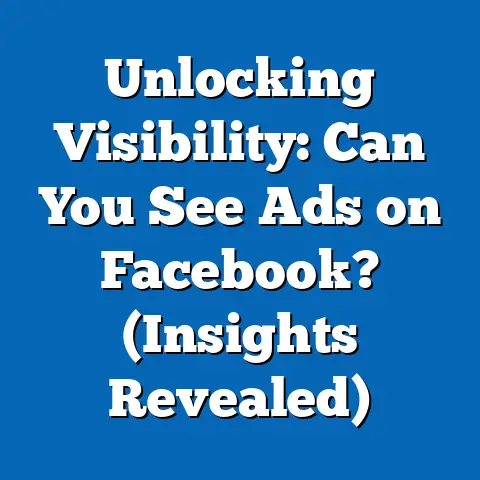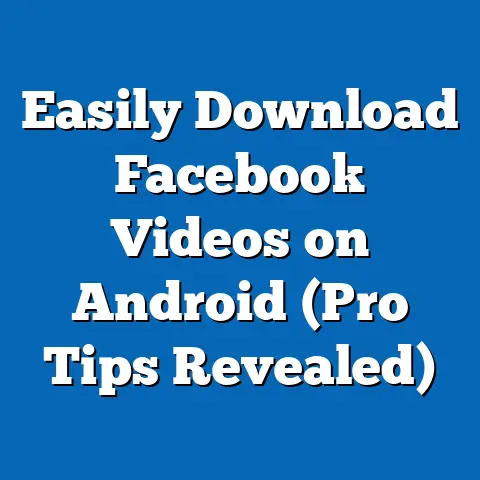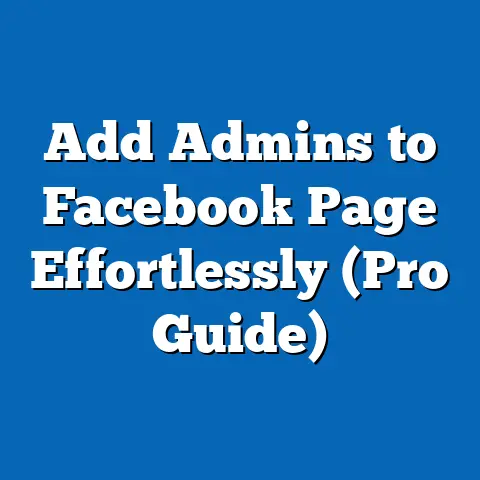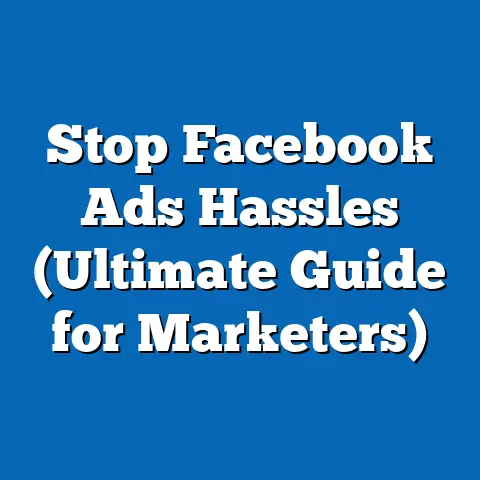Fix Start Date on Duplicated fb ad Sets (Expert Solutions)
Fix Start Date on Duplicated Facebook Ad Sets: Expert Solutions for a Seamless Advertising Experience
Imagine this: You’re a business owner, finally ready to launch your dream product. Or maybe you’re a marketing manager aiming for that promotion. You’ve poured your heart into crafting the perfect Facebook ad campaign. You envision skyrocketing sales, increased brand recognition, and a noticeable shift in your lifestyle – more freedom, more success, and more time for what truly matters. But what if a tiny, seemingly insignificant detail like the start date on your duplicated ad sets is off? Suddenly, your dream campaign is a nightmare, with wasted ad spend and missed opportunities.
Precision in advertising is paramount. Think of it like setting a timer for a crucial event. If the timer is off, you miss the moment. Similarly, incorrect start dates can throw your entire Facebook advertising strategy off course. This guide isn’t just about fixing a technical glitch; it’s about ensuring your hard work translates into tangible results and ultimately contributes to the lifestyle you envision.
Understanding Facebook Ad Sets
Okay, let’s start with the basics. What exactly is a Facebook ad set?
Think of it as the container that holds your ads and dictates who sees them, when they see them, and how much you’re willing to spend to show them. Ad sets are a crucial layer in the structure of your Facebook ad campaigns. They sit beneath the campaign level (which defines your overall objective, like driving traffic or generating leads) and above the individual ad level (where you craft your actual ad creative).
Ad sets are where you define:
- Targeting: Who are you trying to reach? This includes demographics (age, gender, location), interests, behaviors, and even custom audiences based on your existing customer data.
- Budget: How much are you willing to spend daily or over the lifetime of the campaign?
- Scheduling: When do you want your ads to run? This is where the start date (and end date, if applicable) comes into play.
- Placements: Where on Facebook, Instagram, Audience Network, and Messenger do you want your ads to appear?
The start date is, of course, the day your ad set is scheduled to start running. It’s a seemingly simple setting, but it has a huge impact on when your target audience will be exposed to your message.
Takeaway: Ad sets are the control panel for your Facebook ads, and the start date is a critical setting that determines when your ads will be delivered to your target audience.
The Importance of Correct Start Dates
Now, why is getting the start date right so important? Well, imagine launching a promotion for a Black Friday sale… on December 1st. Disaster, right?
Incorrect start dates can lead to a whole host of problems:
- Wasted Ad Spend: If your ad set starts running before you’re ready (maybe your website isn’t live yet, or your product isn’t in stock), you’re essentially throwing money away on impressions that won’t convert.
- Missed Opportunities for Engagement: Conversely, if your ad set starts after a crucial window of opportunity (like a product launch or a seasonal event), you’ll miss out on valuable engagement and potential sales.
- Negative User Experience: Showing ads at the wrong time can annoy your target audience, leading to negative brand perception and decreased engagement. Think about seeing Christmas ads in July – it’s just jarring.
- Skewed Data and Inaccurate Reporting: If your ads are running at the wrong time, your performance data will be skewed, making it difficult to accurately assess the effectiveness of your campaigns and make informed decisions.
Let’s say you’re promoting a limited-time offer that ends on a specific date. If your ad set starts running late, you’ll only be showing ads to a fraction of your target audience during the offer period, drastically reducing your chances of success.
Precise timing is crucial for maximizing audience engagement and ROI. You want to reach the right people with the right message at the right time. A correctly set start date ensures your ads are delivered when your target audience is most receptive and likely to take action.
Takeaway: Don’t underestimate the power of a correctly set start date. It’s the foundation for a successful Facebook ad campaign.
Common Issues with Duplicated Ad Sets
One of the most common ways advertisers create new campaigns quickly is by duplicating existing ad sets. It’s a huge time-saver, especially when you want to test different targeting options or ad creatives while maintaining a consistent structure. However, this is where the start date gremlins often sneak in.
Here’s what can go wrong:
- Inherited Start Dates: When you duplicate an ad set, it often inherits the start date of the original ad set. If you’re not careful, you might accidentally launch the duplicated ad set with a past date, causing it to start running immediately (even if that’s not your intention).
- Automatic Settings Confusion: Facebook’s algorithm can sometimes get confused when dealing with duplicated ad sets, especially if you’re making changes to multiple ad sets at once. This can lead to unexpected start dates and delivery issues.
- Overlooking the Obvious: In the rush to launch a campaign, it’s easy to overlook the start date setting, especially if you’re focusing on other aspects like targeting and creative. This is particularly true if you’re duplicating multiple ad sets at once.
- Time Zone Troubles: If you’re managing campaigns across different time zones, it’s crucial to double-check that the start date is correctly aligned with the target audience’s time zone. A mismatch can lead to ads running at odd hours or even on the wrong days.
I’ve personally seen marketers launch campaigns with duplicated ad sets, only to realize days later that their ads had been running with the wrong start date. The repercussions? Wasted ad spend, missed opportunities, and a whole lot of frustration.
Takeaway: Duplicating ad sets is a convenient way to scale your campaigns, but it’s essential to pay close attention to the start date setting to avoid costly mistakes.
How do you actually fix the start date on duplicated Facebook ad sets? Here’s a step-by-step guide that I’ve used countless times:Step 1: Access the Ads Manager
- Log in to your Facebook account and navigate to the Ads Manager. You can usually find it in the left-hand menu or by searching for “Ads Manager” in the search bar.
- Select the ad account you want to work with.
Step 2: Locate the Duplicated Ad Set
- Within the Ads Manager, navigate to the campaign that contains the duplicated ad set.
- Click on the “Ad Sets” tab to view a list of all ad sets within that campaign.
- Identify the duplicated ad set that needs its start date adjusted.
Step 3: Access the Editing Options
- Click on the name of the duplicated ad set to open its editing options. This will bring up a panel on the right-hand side of the screen.
Step 4: Change the Start Date
- In the editing panel, scroll down to the “Scheduling” section.
- You’ll see a “Start Date” field. Click on this field to open a calendar.
- Select the desired start date from the calendar, ensuring it aligns with your campaign goals.
- If you also want to set an end date, you can do so in the “End Date” field.
- Make sure the time is also correct.
Step 5: Review Other Settings
- After changing the start date, take a moment to review all other settings in the ad set, including targeting, budget, and placements.
- Make sure everything is configured correctly and aligns with your campaign objectives.
Step 6: Publish Your Changes
- Once you’re satisfied with all the settings, click the “Publish” button (or “Review and Publish” if you have multiple changes) to save your changes and activate the ad set with the new start date.
Important Tips:
- Use Visual Aids: Screenshots or visual aids can be incredibly helpful for guiding users through the process.
- Double-Check Everything: It’s always a good idea to double-check all settings after duplication to avoid any misconfigurations.
- Maintain Consistency: Try to maintain consistency across ad sets and campaigns to streamline future duplications. This includes using consistent naming conventions and standardized settings.
Example:
Let’s say you’re launching a new ad set for a summer sale. You duplicate an existing ad set from a previous campaign, but you forget to change the start date. The old ad set was scheduled to start on May 1st, but your summer sale doesn’t begin until June 15th.
Following the steps above, you would navigate to the duplicated ad set, access the scheduling section, and change the start date to June 15th. You would also review the other settings to make sure they’re relevant to your summer sale, such as updating the ad creative and targeting options.
Takeaway: Fixing start dates on duplicated ad sets is a straightforward process, but it requires attention to detail and a systematic approach.
Proactive Measures to Prevent Start Date Errors
Prevention is always better than cure, right? Here are some proactive strategies you can adopt to prevent start date issues from happening in the first place:
- Plan and Schedule in Advance: Don’t wait until the last minute to create your ad campaigns. Plan your campaigns in advance and schedule your ad sets with the correct start dates ahead of time. This gives you plenty of time to review everything and catch any potential errors.
- Use Facebook’s Scheduling Tools Effectively: Facebook offers a variety of scheduling tools that can help you manage your ad campaigns more efficiently. Use these tools to schedule your ad sets to start and stop at specific times, ensuring they run exactly when you want them to.
- Set Reminders and Checklists: Create reminders or checklists to ensure all aspects of your ad sets are reviewed before launching campaigns. This should include a specific item for verifying the start date.
- Establish Naming Conventions: Use clear and descriptive naming conventions for your ad sets and campaigns. This makes it easier to identify the correct ad sets and avoid confusion when duplicating them.
- Team Collaboration: If you’re working with a team, make sure everyone is aware of the importance of start dates and has a clear understanding of the scheduling process. Encourage team members to double-check each other’s work to catch any potential errors.
Example:
Before launching a new campaign, create a checklist that includes the following items:
- Verify the campaign objective
- Confirm the target audience
- Review the ad creative
- Double-check the start date
- Set the budget
- Select the placements
By following this checklist, you’ll be much less likely to overlook the start date setting and make costly mistakes.
Takeaway: By implementing proactive measures, you can significantly reduce the risk of start date errors and ensure your Facebook ad campaigns run smoothly and effectively.
Conclusion
Managing start dates in Facebook ad sets might seem like a small detail, but it can have a significant impact on the success of your campaigns. Taking the time to fix these details can lead to more effective advertising, increased ROI, and ultimately, a better lifestyle for marketers and business owners. Remember, every successful campaign is built on a foundation of careful planning and attention to detail. So, implement the solutions discussed, view your advertising efforts as an investment in your future success, and watch your dreams become a reality. Now, go out there and conquer the world of Facebook advertising, one perfectly timed ad set at a time!





